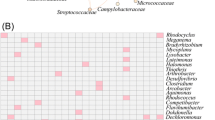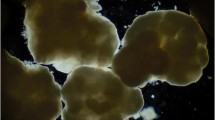Abstract
Microbial aggregation into good settling sludge is essential for the well-functioning of activated sludge systems treating waste water. Complete aggregation of all the microbial biomass formed has been proven to be difficult to maintain continuously, resulting in wash-out of suspended solids. This review investigates the possibility that environmental signals could constitute triggers for the induction or stimulation of aggregative physiology.
Similar content being viewed by others
References
Anderson KL, Salyers AA (1989a) Biochemical evidence that starch breakdown by Bacteroides thetaiotaomicron involves outer membrane starch-binding sites and periplasmic starch-degrading enzymes. J Bacteriol 171: 3192–3198
Anderson KL, Salyers AA (1989b) Genetic evidence that outer membrane binding of starch is required for starch utilization by Bacteroides thetaiotaomicron. J Bacteriol 171: 3199–3204
Andersson A, Larson U, Hagström A (1986) Size-selective grazing by a microflagellate on pelagic bacteria. Mar Ecol Prog Ser 33: 51–57
Anwar H, Strap JL. Costerton JW (1992) Establishment of aging biofilms: possible mechanisms of bacterial resistance to antimicrobial therapy. Antimicrob Agents Chemother 36: 1347–1351
Arnqvist A, Olsén A, Pfeifer J, Russel DG, Normark S (1992) The Crl proteins activate cryptic genes for curli formation and fibronectin binding in Escherichia coli. Mol Microbiol 6: 2443–2452
Barlett DH, Wright ME, Silverman M (1988) Variable expression of extracellular polysaccharide in the marine bacterium Pseudomonas atlantica is controlled by genome rearrangement. Proc Natl Acad Sci USA 85: 3923–3927
Béguin P (1990) Molecular biology of cellulose degradation. Annu Rev Microbiol 44: 219–248
Berthouex PM, Fan R (1986) Evaluation of treatment plant performance: causes, frequency, and duration of upsets. J Water Pollut Control Fed 58: 368–375
Brown MJ, Lester JN (1979) Metal removal in activated sludge: the role of bacterial extracellular polymers. Water Res 13: 817–837
Calleja GB (1987) Cell aggregation, In: Rose AH, Harrison JS (eds) The yeasts, vol 2, 2nd edn. Academic, London, pp 165–238
Chiesa SC, Irvine RL, Manning JF (1985) Feast/famine growth environments and activated sludge population selection. Biotechnol Bioeng 27: 562–569
Corzo J, Léon-Barrios M, Hernando-Rico V, Gutierrez-Navarro AM (1994) Precipitation of metallic cations by the acidic cxopolysaccharides from Bradyrhizobium japonicum and Bradyrhizobium (Chamaecytisus) strain BGA-1. Appl Environ Microbiol 60: 4531–4536
Costerton JW, Cheng K-J, Geesey GG, Ladd TI, Nickel JC, Dasgupta M, Marrie TJ (1987) Bacterial biofilms in nature and disease. Annu Rev Microbiol 41: 435–464
Dalton HH, Poulsen LK, Halasz ML, Angles AE, Goodman AE, Marshall KC (1994) Substratum-induced morphological changes in marine bactrium and their relevance to biofilm structure. J Bacteriol 176: 6900–6906
Davies D, Chakarbarty A, Geesay G (1993) Exopolysaccharides production in biofilms: substrate activation of alginate gene expression by Pseudomonas aeruginosa. Appl Environ Microbiol 59: 1181–1186
Dawson MP, Humphrey BA, Marshall KC (1981) Adhesion, a tactic in the survival strategy of a marine vibrio during starvation. Curr Microbiol 6: 195–199
Felix DR, Ljungdahl LG (1993) The cellulosome: the exocellular organelle of Clostridium. Annu Rev Microbiol 47: 791–819
Gancedo JM (1992) Carbon catabolite repression in yeast. Eur J Biochem 206: 297–313
Geddie JL, Sutherland IL (1993) Uptake of metals by bacterial polysaccharides. J Appl Bacteriol 74: 467–472
Giwercman B, Jensen ET, Haiby N, Kharazmi A, Costerton JW (1991) Induction of β-lactamase production in Pseudomonas aeruginosa biofilms. Antimicrob Agents Chemother 35: 1008–1010
van Haandel AC, Lettinga G (1994) Anaerobic sewage treatment: a practical guide for regions with a hot climate. Wiley, New York, p 225
Hantula J, Bamford DH (1991) The efficiency of the protein-dependent flocculation of Flavobacterium sp is sensitive to the composition of growth medium. Appl Microbiol Biotechnol 36: 100–104
Herman DC, Costerton JW (1993) Starvation-survival of a p-nitrophenol-degrading bacterium. Appl Environ Microbiol 59: 340–343
Horan NJ (1991) Biological wastewater treatment systems: theory and operation John Wiley, New York p 310
James GA, Korber DR, Caldwell DE, Costerton JW (1995) Digital image analysis of growth and starvation responses of a surface-colonising Acinetobacter sp. J Bacteriol 177: 907–915
Kjelleberg S, Hermansson M (1984) Starvation-induced effects on bacterial surface characteristics. Appl Environ Microbiol 48: 497–503
Kjelleberg S, Hermansson M, Mardén P, Jones GW (1987) The transient phase between growth and nongrowth of heterotrophic bacteria, with emphasis on the marine environment. Annu Rev Microbiol 41: 25–49
Logan BE, Hunt JR (1988) Bioflocculation as a microbial response to substrate limitations. Biotechnol Bioeng 31: 91–101
Macleod FA, Lappin-Scott HM, Costerton JW (1988) Plugging of a model rock system by using starved bacteria. Appl Environ Microbiol 54: 1365–1372
Marshall KC, Goodman AE (1994) Effects of adhesion on microbial cell physiology. Colloids Surfaces B Biointerfaces 2: 1–7
Masduki A, Nakamura J, Ohga T, Umezaki R, Kato J, Ohtake H (1995) Isolation and characterisation of chemotaxis mutants and genes of Pseudomonas aeruginosa. J Bacteriol 177: 948–952
McFeters GA, Egli T, Wilberg E, Adler A, Schneider R, Snozzi M, Giger W (1990) Activity and adaptation of nitrilotriacetate (NTA)-degrading bacteria: field and laboratory studies. Water Res 24: 875–881
Montgomery MT, Kirchman DL (1994) Induction of chitinbinding proteins during the specific attachment of the marine bacterium Vibiro harveyi to chitin. Appl Environ Microbiol 60: 4284–4288
Olsén A, Jonssen A, Normark S (1989) Fibronectin binding mediated by a novel class of surface organelles on Escherichia coli. Nature 338: 652–655
Parkinson JS (1978) Complementation analysis and deletion mapping of Escherichia coli mutants defective in chemotaxis. J Bacteriol 135: 45–53
Plude JL, Parker DL, Schommer OJ, Timmerman RJ, Hagstrom SA, Joers JJ, Hnasko R (1991) Chemical characterisation of polysaccharides from the slime layer of the cyanobacterium Microcystis flos-aqua C3-40. Appl Environ Microbiol 57: 1696–1700
Rainey PB, Moxon ER, Thompson IP (1993) Intraclonal polymorphism in bacteria Adv Microb Ecol 13: 263–300
Rudd T, Steritt RM, Lester JM (1984) Complexation of heavy metals by extracellular polymers in the activated sludge process. J Water Pollut Control Fed 56: 1260–1268
Saier MH (1989) Protein phosphorylation and allosteric control of inducer exclusion and catabolite repression by the bacterial phosphoenolpyruvate: sugar phosphotransferase system. Microbial Rev 53: 109–120
Sezgin M, Jenkins D, Parker DS (1978) A unified theory of filamentous activated sludge bulking. J Water Pollut Control Fed 50: 362–387
Shikano S, Luckenbill LS, Kurihara Y (1990) Changes of traits in a bacterial population associated with protozoal predation. Microb Ecol 20: 75–84
Stock JB, Stock AM, Mottonen JM (1990) Signal transduction in bacteria. Nature 344: 395–400
Stock JB, Lukat GS, Stock AM (1991) Bacterial chemotaxis and the molecular logic of intracellular signal transduction networks. Annu Rev Biophys Chem 20: 109–136
Thevelein JM, Hohmann S (1995) Trehalose synthase, guard to the gate of glycolysis in yeast. Trends Biochem Sci 20: 3–10
Urbain V, Block JC, Manem J (1993) Bioflocculation in activated sludge: an analytical approach. Water Res 27: 829–838
Van Loosdrecht NCM, Lyklema J, Norde W, Zehnder AJB (1990) Influence of interfaces on microbial activity. Microbiol Rev 54: 75–87
Verstraete W, Van Vaerenbergh E (1986) Aerobic activated sludge. In: Rehm HJ, Reed G (eds) Biotechnology, vol 8. VCH Verlagsgesellschaft, Weinheim pp 44–102
Vickerman MM, Clewell DB, Jones GW (1991) Ecological implications of glysosyl transferase phase variation in Streptococcus gordonii. Appl Environ Microbiol 57: 3648–3651
Wallace WH, Fleming JT, White DC, Sayler GS (1994) An algD-bioluminescent reporter plasmid to monitor alginate production in biofilms. Microb Ecol 27: 225–239
Warne SR, Varley JM, Boulnois GJ, Norton MG (1990) Identification and characterisation of a gene that controls colony morphology and auto-aggregation in Escherichia coli K12. J Gen Microbiol 136: 455–462
Wrangstadh M, Conway P, Kjelleberg S (1986) The production and release of an extracellular polysaccharide during starvation of a marine Pseudomonas sp and the effect thereof on the adhesion. Arch Microbiol 145: 220–227
Wrangstadh M, Conway P, Kjelleberg S (1989) The role of an extracellular polysaccharide produced by the marine Pseudomonas sp S9 in cellular detachment during starvation. Can J Microbiol 35: 309–312
Author information
Authors and Affiliations
Rights and permissions
About this article
Cite this article
Bossier, P., Verstraete, W. Triggers for microbial aggregation in activated sludge?. Appl Microbiol Biotechnol 45, 1–6 (1996). https://doi.org/10.1007/s002530050640
Received:
Accepted:
Issue Date:
DOI: https://doi.org/10.1007/s002530050640




